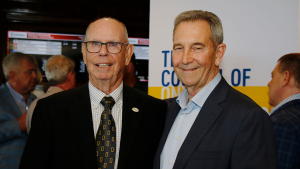The Canadian consulting engineering firm exp has been recognized for its excellence in rebuilding the J.-M.-Jeanson drinking water treatment plant in Sherbrooke, Que. with a Leonard award as the province’s best urban infrastructure project.
It was a project of superlatives: the drinking water it produces is so clear, it is 10 times better in terms of turbidity than Quebec regulations demand; the plant represents the largest water ozonation system in the world using very-high-frequency ozone generation technology; it came in 10 per cent under budget; and the system returns a miniscule 0.4 per cent of the draw water to the wastewater system, compared with a typical five or 10 per cent.
The build was completed in June of 2015.
Exp’s Sherbrooke-based project manager Jean-Yves Lavoie and his Montreal-based engineering colleague Julie Cormier, who oversaw the design of the two-phased filtration system that represents the largest drinking water membrane filtration system in Quebec, explained in a conference call how the technical elements were pieced together to produce the prize-winning result.
They reiterated a statement issued by exp president and CEO Vlad Stritesky when the Leonard award was announced mid May.
"Through the perfect integration of high-performing and innovative technologies, the Sherbrooke J.-M.-Jeanson drinking water treatment plant represents a major technological step forward from which cities and consulting engineers can draw for future generations," said Stritesky.
"We are consulting engineers, we are not manufacturers," explained Cormier of the configuration of systems they incorporated into the Sherbrooke plant. "We use technology from manufacturers and we put it together, so we are able to carry out the design of different systems adapted to a particular water system."
The treatment process consists of filtration followed by ozonation.
Exp conducted pilot tests examining membranes of varying porosity with the goal of achieving the best water quality at a low cost while minimizing the use of chemicals. Following the calls of tenders for the preselection of the micro filtration process, Pall Corporation Inc., a manufacturer based in New York State, won the bid.
Cormier explained, "This is the first time we have added a secondary membrane filtration allowing for treatment of primary filter backwash wastewater. Water treated by secondary filtration is reused for backwashing membranes instead of using drinking water."
This system, implemented in Sherbrooke, is one of the few secondary membrane filtration systems in use on the continent, she said.
Water goes through an ozonation process to kill bacteria and eliminate other impurities. Exp opted for a system manufactured by Pinnacle of Florida that is compact and highly automated. It had never been used on a project this large before, said Lavoie.
"Before there was other technology, medium frequency and low frequency, but now we have new technology, very high frequency, that was used before on boats, on small installations, but not on installations capable of supplying 150,000 people like our plant," he explained.
The original plant was built in 1977 and upgrades were due. The build was done in two phases. Exp worked with mechanical engineers Allen Entrepreneur General of St-Henri, Que. on the first contract, which involved installing the microfiltration system. For phase two, Exp partnered with a general contractor, Construction Longer of Sherbrooke, to complete the plant and build a laboratory and control room.
The build started in January 2013 took two-and-a-half years, using crews of about 30 workers on site, Lavoie said — a longer period than could have otherwise been managed, he said, because the existing plant had to remain operational at all times.
"It was very important to keep uninterrupted drinking water throughout the construction," he said.
The budget was $35 million but even with the state-of-the-art technology, exp got the job done spending only $31.4 million.
"We proved that this type of technology is not any more expensive than conventional technology," said Cormier. "For one, it does not take a lot of space, so the building is smaller, so the global project is less expensive."
"Ten years ago it was too expensive but now, it is competitive," said Lavoie.
With all the new technology used, does the water taste better?
No, said Lavoie, but that was not the point of the exercise.
"Now the regulations are respected," he said. "It was not a matter of taste. The turbidity is better, the organic matter is reduced."
The Leonard awards, officially called the Grands Prix du génie-conseil québécois, honour Quebec’s best engineering projects each year submitted by consulting engineers.





Recent Comments
comments for this post are closed